Applied Business Research: Sustainable Tourism Development Challenges
VerifiedAdded on 2023/04/20
|12
|2830
|362
Report
AI Summary
This report examines the issues and challenges in sustainable tourism development, focusing on Air New Zealand's approach. It reviews literature on sustainable tourism principles, highlighting the importance of balancing economic, social, and environmental needs. The report identifies challenges such as the lack of tourism potential, mechanical know-how, and diversification. It also discusses how Air New Zealand measures sustainable tourism through carbon emissions and environmental impact, using performance indicators and SMART objectives. The report further explores the challenges posed by sustainable tourism to Air New Zealand, including carbon emissions and the need for innovative solutions. It emphasizes the company's efforts to promote regional dispersal, support domestic network development, and engage in marketing partnerships to enhance New Zealand's appeal as a sustainable destination. Desklib provides access to this document along with a wide array of study tools and resources.
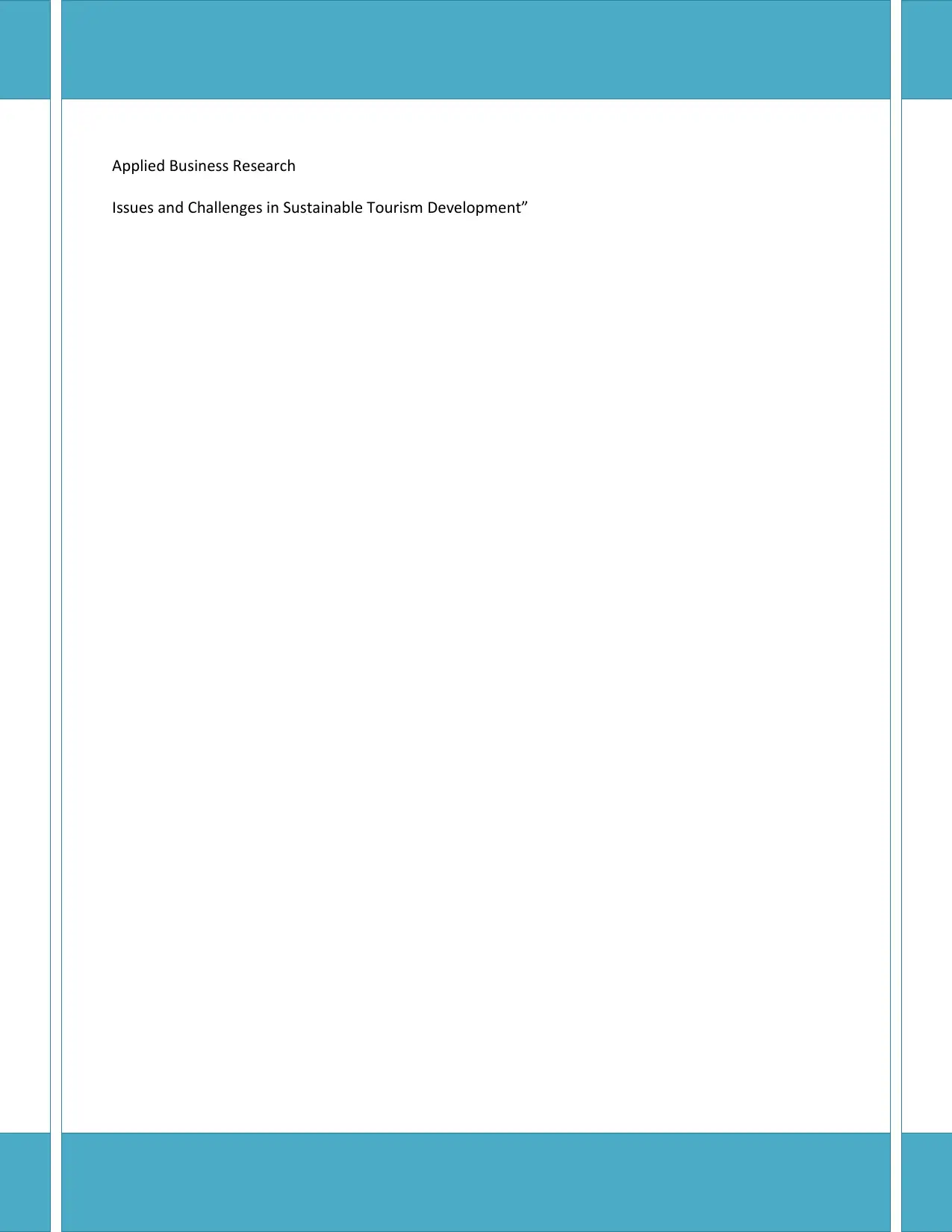
Applied Business Research
Issues and Challenges in Sustainable Tourism Development”
Issues and Challenges in Sustainable Tourism Development”
Paraphrase This Document
Need a fresh take? Get an instant paraphrase of this document with our AI Paraphraser
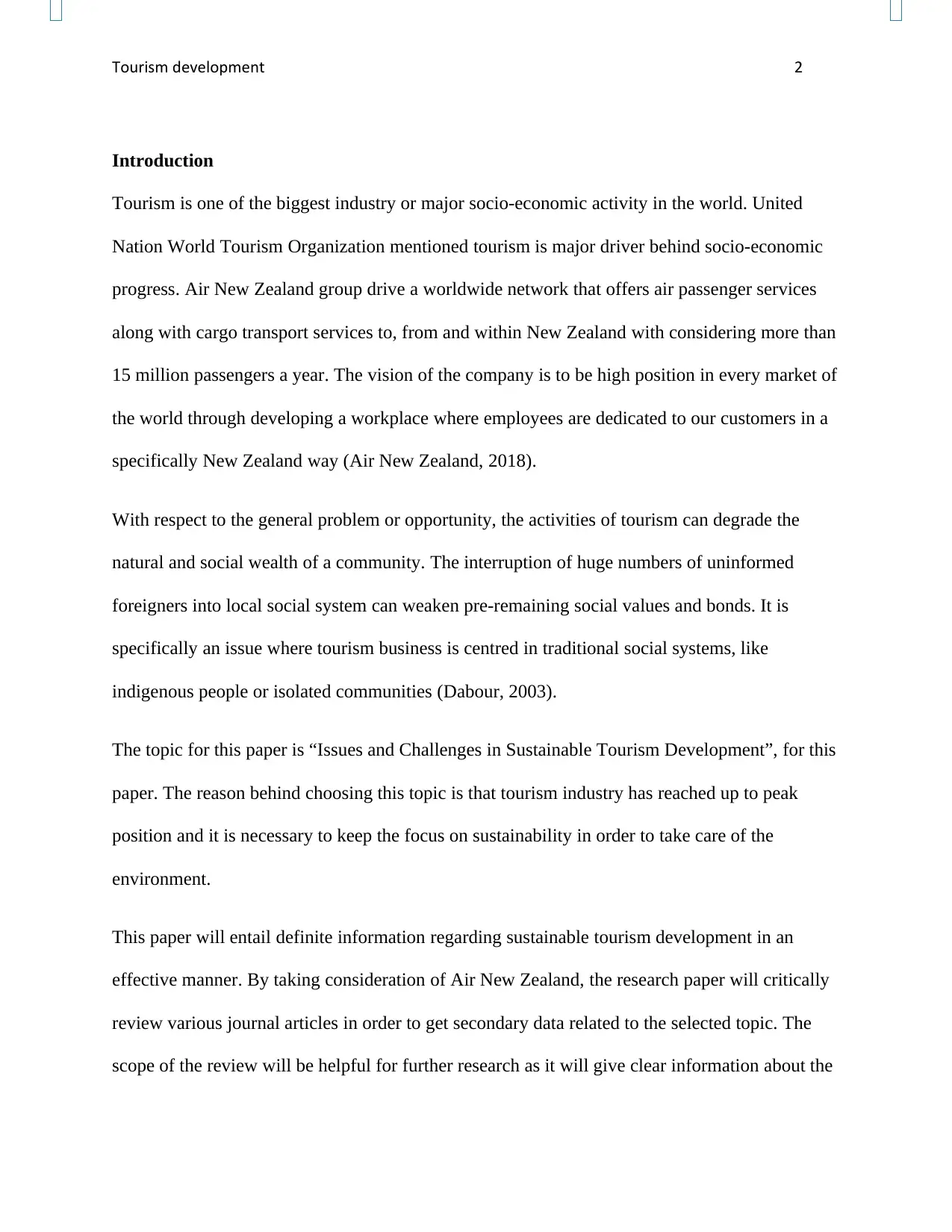
Tourism development 2
Introduction
Tourism is one of the biggest industry or major socio-economic activity in the world. United
Nation World Tourism Organization mentioned tourism is major driver behind socio-economic
progress. Air New Zealand group drive a worldwide network that offers air passenger services
along with cargo transport services to, from and within New Zealand with considering more than
15 million passengers a year. The vision of the company is to be high position in every market of
the world through developing a workplace where employees are dedicated to our customers in a
specifically New Zealand way (Air New Zealand, 2018).
With respect to the general problem or opportunity, the activities of tourism can degrade the
natural and social wealth of a community. The interruption of huge numbers of uninformed
foreigners into local social system can weaken pre-remaining social values and bonds. It is
specifically an issue where tourism business is centred in traditional social systems, like
indigenous people or isolated communities (Dabour, 2003).
The topic for this paper is “Issues and Challenges in Sustainable Tourism Development”, for this
paper. The reason behind choosing this topic is that tourism industry has reached up to peak
position and it is necessary to keep the focus on sustainability in order to take care of the
environment.
This paper will entail definite information regarding sustainable tourism development in an
effective manner. By taking consideration of Air New Zealand, the research paper will critically
review various journal articles in order to get secondary data related to the selected topic. The
scope of the review will be helpful for further research as it will give clear information about the
Introduction
Tourism is one of the biggest industry or major socio-economic activity in the world. United
Nation World Tourism Organization mentioned tourism is major driver behind socio-economic
progress. Air New Zealand group drive a worldwide network that offers air passenger services
along with cargo transport services to, from and within New Zealand with considering more than
15 million passengers a year. The vision of the company is to be high position in every market of
the world through developing a workplace where employees are dedicated to our customers in a
specifically New Zealand way (Air New Zealand, 2018).
With respect to the general problem or opportunity, the activities of tourism can degrade the
natural and social wealth of a community. The interruption of huge numbers of uninformed
foreigners into local social system can weaken pre-remaining social values and bonds. It is
specifically an issue where tourism business is centred in traditional social systems, like
indigenous people or isolated communities (Dabour, 2003).
The topic for this paper is “Issues and Challenges in Sustainable Tourism Development”, for this
paper. The reason behind choosing this topic is that tourism industry has reached up to peak
position and it is necessary to keep the focus on sustainability in order to take care of the
environment.
This paper will entail definite information regarding sustainable tourism development in an
effective manner. By taking consideration of Air New Zealand, the research paper will critically
review various journal articles in order to get secondary data related to the selected topic. The
scope of the review will be helpful for further research as it will give clear information about the
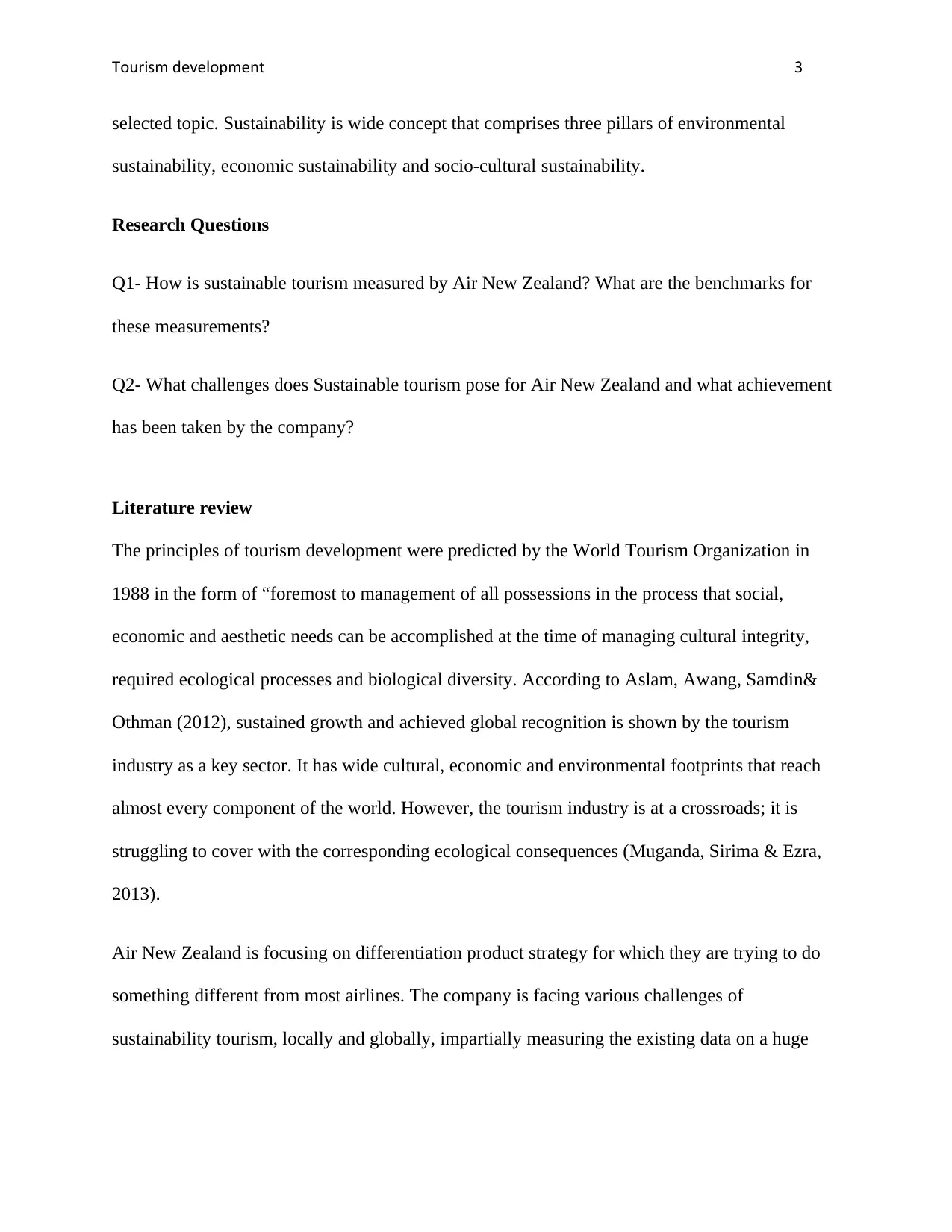
Tourism development 3
selected topic. Sustainability is wide concept that comprises three pillars of environmental
sustainability, economic sustainability and socio-cultural sustainability.
Research Questions
Q1- How is sustainable tourism measured by Air New Zealand? What are the benchmarks for
these measurements?
Q2- What challenges does Sustainable tourism pose for Air New Zealand and what achievement
has been taken by the company?
Literature review
The principles of tourism development were predicted by the World Tourism Organization in
1988 in the form of “foremost to management of all possessions in the process that social,
economic and aesthetic needs can be accomplished at the time of managing cultural integrity,
required ecological processes and biological diversity. According to Aslam, Awang, Samdin&
Othman (2012), sustained growth and achieved global recognition is shown by the tourism
industry as a key sector. It has wide cultural, economic and environmental footprints that reach
almost every component of the world. However, the tourism industry is at a crossroads; it is
struggling to cover with the corresponding ecological consequences (Muganda, Sirima & Ezra,
2013).
Air New Zealand is focusing on differentiation product strategy for which they are trying to do
something different from most airlines. The company is facing various challenges of
sustainability tourism, locally and globally, impartially measuring the existing data on a huge
selected topic. Sustainability is wide concept that comprises three pillars of environmental
sustainability, economic sustainability and socio-cultural sustainability.
Research Questions
Q1- How is sustainable tourism measured by Air New Zealand? What are the benchmarks for
these measurements?
Q2- What challenges does Sustainable tourism pose for Air New Zealand and what achievement
has been taken by the company?
Literature review
The principles of tourism development were predicted by the World Tourism Organization in
1988 in the form of “foremost to management of all possessions in the process that social,
economic and aesthetic needs can be accomplished at the time of managing cultural integrity,
required ecological processes and biological diversity. According to Aslam, Awang, Samdin&
Othman (2012), sustained growth and achieved global recognition is shown by the tourism
industry as a key sector. It has wide cultural, economic and environmental footprints that reach
almost every component of the world. However, the tourism industry is at a crossroads; it is
struggling to cover with the corresponding ecological consequences (Muganda, Sirima & Ezra,
2013).
Air New Zealand is focusing on differentiation product strategy for which they are trying to do
something different from most airlines. The company is facing various challenges of
sustainability tourism, locally and globally, impartially measuring the existing data on a huge
⊘ This is a preview!⊘
Do you want full access?
Subscribe today to unlock all pages.

Trusted by 1+ million students worldwide
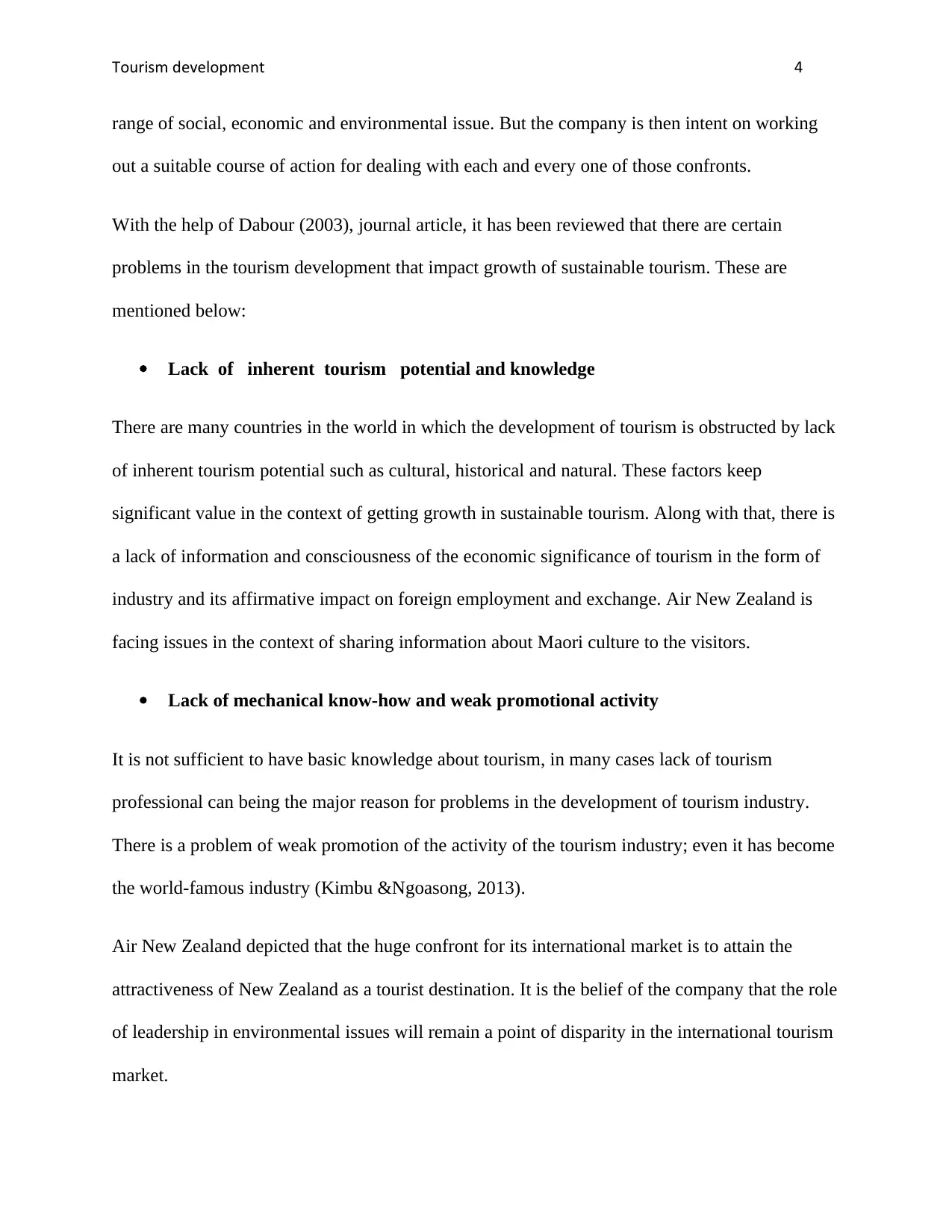
Tourism development 4
range of social, economic and environmental issue. But the company is then intent on working
out a suitable course of action for dealing with each and every one of those confronts.
With the help of Dabour (2003), journal article, it has been reviewed that there are certain
problems in the tourism development that impact growth of sustainable tourism. These are
mentioned below:
Lack of inherent tourism potential and knowledge
There are many countries in the world in which the development of tourism is obstructed by lack
of inherent tourism potential such as cultural, historical and natural. These factors keep
significant value in the context of getting growth in sustainable tourism. Along with that, there is
a lack of information and consciousness of the economic significance of tourism in the form of
industry and its affirmative impact on foreign employment and exchange. Air New Zealand is
facing issues in the context of sharing information about Maori culture to the visitors.
Lack of mechanical know-how and weak promotional activity
It is not sufficient to have basic knowledge about tourism, in many cases lack of tourism
professional can being the major reason for problems in the development of tourism industry.
There is a problem of weak promotion of the activity of the tourism industry; even it has become
the world-famous industry (Kimbu &Ngoasong, 2013).
Air New Zealand depicted that the huge confront for its international market is to attain the
attractiveness of New Zealand as a tourist destination. It is the belief of the company that the role
of leadership in environmental issues will remain a point of disparity in the international tourism
market.
range of social, economic and environmental issue. But the company is then intent on working
out a suitable course of action for dealing with each and every one of those confronts.
With the help of Dabour (2003), journal article, it has been reviewed that there are certain
problems in the tourism development that impact growth of sustainable tourism. These are
mentioned below:
Lack of inherent tourism potential and knowledge
There are many countries in the world in which the development of tourism is obstructed by lack
of inherent tourism potential such as cultural, historical and natural. These factors keep
significant value in the context of getting growth in sustainable tourism. Along with that, there is
a lack of information and consciousness of the economic significance of tourism in the form of
industry and its affirmative impact on foreign employment and exchange. Air New Zealand is
facing issues in the context of sharing information about Maori culture to the visitors.
Lack of mechanical know-how and weak promotional activity
It is not sufficient to have basic knowledge about tourism, in many cases lack of tourism
professional can being the major reason for problems in the development of tourism industry.
There is a problem of weak promotion of the activity of the tourism industry; even it has become
the world-famous industry (Kimbu &Ngoasong, 2013).
Air New Zealand depicted that the huge confront for its international market is to attain the
attractiveness of New Zealand as a tourist destination. It is the belief of the company that the role
of leadership in environmental issues will remain a point of disparity in the international tourism
market.
Paraphrase This Document
Need a fresh take? Get an instant paraphrase of this document with our AI Paraphraser
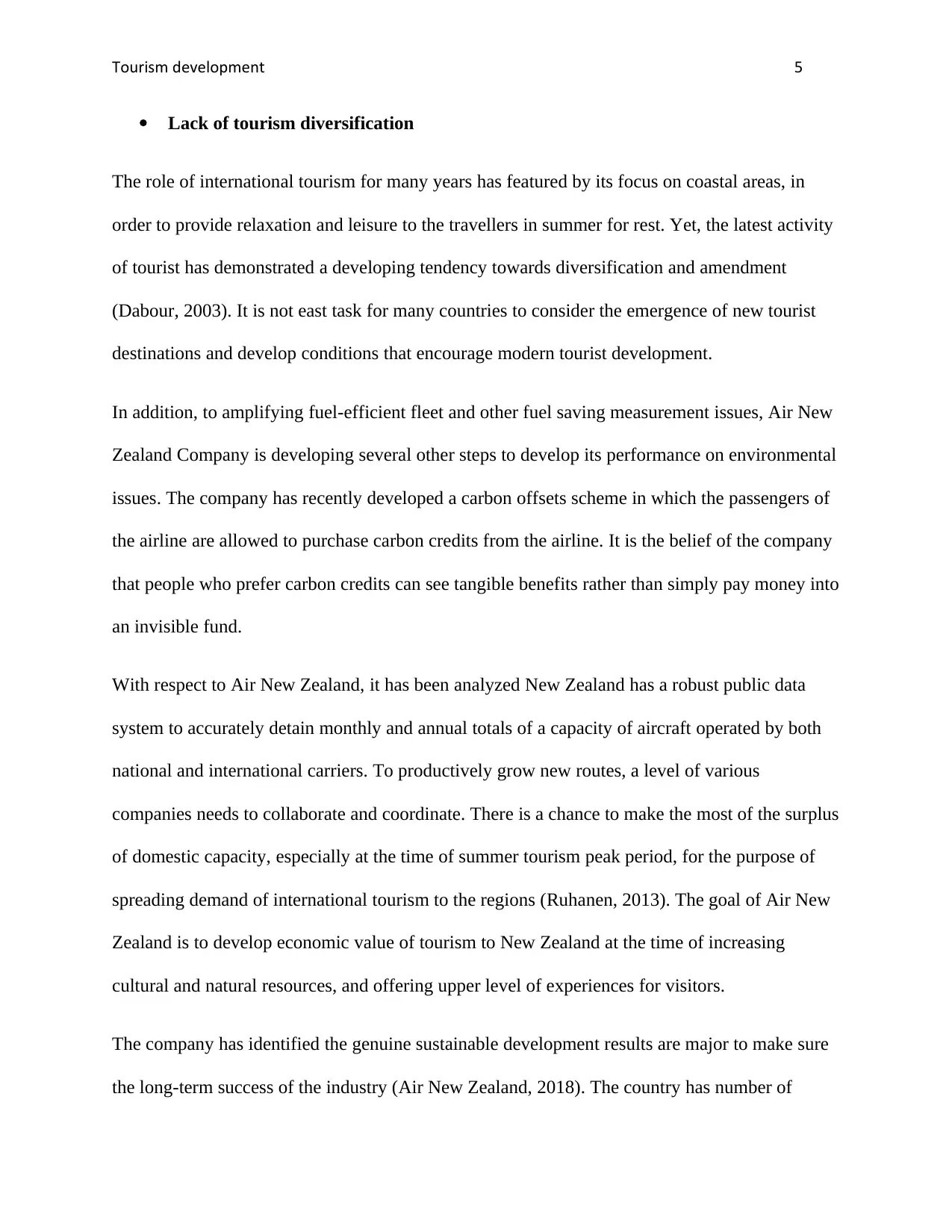
Tourism development 5
Lack of tourism diversification
The role of international tourism for many years has featured by its focus on coastal areas, in
order to provide relaxation and leisure to the travellers in summer for rest. Yet, the latest activity
of tourist has demonstrated a developing tendency towards diversification and amendment
(Dabour, 2003). It is not east task for many countries to consider the emergence of new tourist
destinations and develop conditions that encourage modern tourist development.
In addition, to amplifying fuel-efficient fleet and other fuel saving measurement issues, Air New
Zealand Company is developing several other steps to develop its performance on environmental
issues. The company has recently developed a carbon offsets scheme in which the passengers of
the airline are allowed to purchase carbon credits from the airline. It is the belief of the company
that people who prefer carbon credits can see tangible benefits rather than simply pay money into
an invisible fund.
With respect to Air New Zealand, it has been analyzed New Zealand has a robust public data
system to accurately detain monthly and annual totals of a capacity of aircraft operated by both
national and international carriers. To productively grow new routes, a level of various
companies needs to collaborate and coordinate. There is a chance to make the most of the surplus
of domestic capacity, especially at the time of summer tourism peak period, for the purpose of
spreading demand of international tourism to the regions (Ruhanen, 2013). The goal of Air New
Zealand is to develop economic value of tourism to New Zealand at the time of increasing
cultural and natural resources, and offering upper level of experiences for visitors.
The company has identified the genuine sustainable development results are major to make sure
the long-term success of the industry (Air New Zealand, 2018). The country has number of
Lack of tourism diversification
The role of international tourism for many years has featured by its focus on coastal areas, in
order to provide relaxation and leisure to the travellers in summer for rest. Yet, the latest activity
of tourist has demonstrated a developing tendency towards diversification and amendment
(Dabour, 2003). It is not east task for many countries to consider the emergence of new tourist
destinations and develop conditions that encourage modern tourist development.
In addition, to amplifying fuel-efficient fleet and other fuel saving measurement issues, Air New
Zealand Company is developing several other steps to develop its performance on environmental
issues. The company has recently developed a carbon offsets scheme in which the passengers of
the airline are allowed to purchase carbon credits from the airline. It is the belief of the company
that people who prefer carbon credits can see tangible benefits rather than simply pay money into
an invisible fund.
With respect to Air New Zealand, it has been analyzed New Zealand has a robust public data
system to accurately detain monthly and annual totals of a capacity of aircraft operated by both
national and international carriers. To productively grow new routes, a level of various
companies needs to collaborate and coordinate. There is a chance to make the most of the surplus
of domestic capacity, especially at the time of summer tourism peak period, for the purpose of
spreading demand of international tourism to the regions (Ruhanen, 2013). The goal of Air New
Zealand is to develop economic value of tourism to New Zealand at the time of increasing
cultural and natural resources, and offering upper level of experiences for visitors.
The company has identified the genuine sustainable development results are major to make sure
the long-term success of the industry (Air New Zealand, 2018). The country has number of
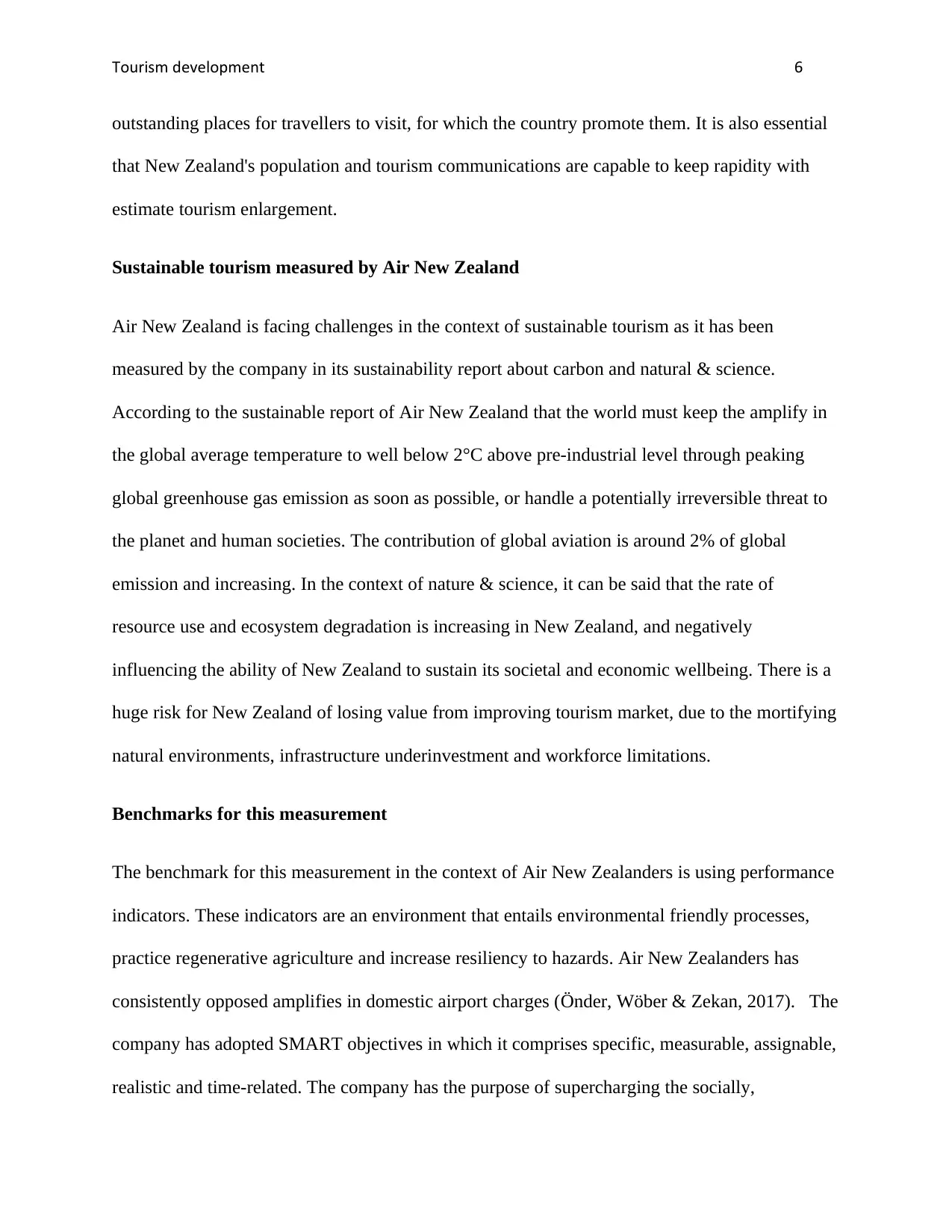
Tourism development 6
outstanding places for travellers to visit, for which the country promote them. It is also essential
that New Zealand's population and tourism communications are capable to keep rapidity with
estimate tourism enlargement.
Sustainable tourism measured by Air New Zealand
Air New Zealand is facing challenges in the context of sustainable tourism as it has been
measured by the company in its sustainability report about carbon and natural & science.
According to the sustainable report of Air New Zealand that the world must keep the amplify in
the global average temperature to well below 2°C above pre-industrial level through peaking
global greenhouse gas emission as soon as possible, or handle a potentially irreversible threat to
the planet and human societies. The contribution of global aviation is around 2% of global
emission and increasing. In the context of nature & science, it can be said that the rate of
resource use and ecosystem degradation is increasing in New Zealand, and negatively
influencing the ability of New Zealand to sustain its societal and economic wellbeing. There is a
huge risk for New Zealand of losing value from improving tourism market, due to the mortifying
natural environments, infrastructure underinvestment and workforce limitations.
Benchmarks for this measurement
The benchmark for this measurement in the context of Air New Zealanders is using performance
indicators. These indicators are an environment that entails environmental friendly processes,
practice regenerative agriculture and increase resiliency to hazards. Air New Zealanders has
consistently opposed amplifies in domestic airport charges (Önder, Wöber & Zekan, 2017). The
company has adopted SMART objectives in which it comprises specific, measurable, assignable,
realistic and time-related. The company has the purpose of supercharging the socially,
outstanding places for travellers to visit, for which the country promote them. It is also essential
that New Zealand's population and tourism communications are capable to keep rapidity with
estimate tourism enlargement.
Sustainable tourism measured by Air New Zealand
Air New Zealand is facing challenges in the context of sustainable tourism as it has been
measured by the company in its sustainability report about carbon and natural & science.
According to the sustainable report of Air New Zealand that the world must keep the amplify in
the global average temperature to well below 2°C above pre-industrial level through peaking
global greenhouse gas emission as soon as possible, or handle a potentially irreversible threat to
the planet and human societies. The contribution of global aviation is around 2% of global
emission and increasing. In the context of nature & science, it can be said that the rate of
resource use and ecosystem degradation is increasing in New Zealand, and negatively
influencing the ability of New Zealand to sustain its societal and economic wellbeing. There is a
huge risk for New Zealand of losing value from improving tourism market, due to the mortifying
natural environments, infrastructure underinvestment and workforce limitations.
Benchmarks for this measurement
The benchmark for this measurement in the context of Air New Zealanders is using performance
indicators. These indicators are an environment that entails environmental friendly processes,
practice regenerative agriculture and increase resiliency to hazards. Air New Zealanders has
consistently opposed amplifies in domestic airport charges (Önder, Wöber & Zekan, 2017). The
company has adopted SMART objectives in which it comprises specific, measurable, assignable,
realistic and time-related. The company has the purpose of supercharging the socially,
⊘ This is a preview!⊘
Do you want full access?
Subscribe today to unlock all pages.

Trusted by 1+ million students worldwide
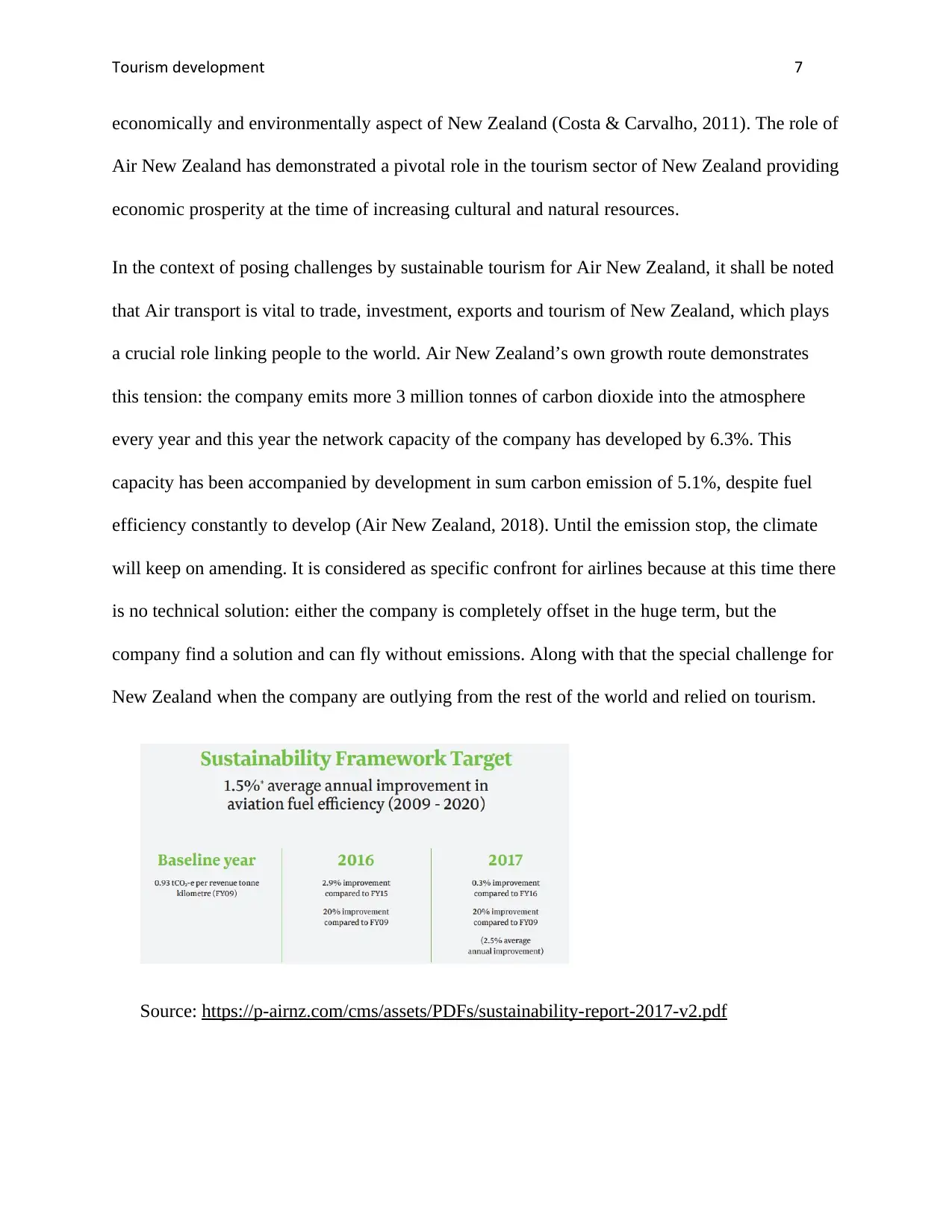
Tourism development 7
economically and environmentally aspect of New Zealand (Costa & Carvalho, 2011). The role of
Air New Zealand has demonstrated a pivotal role in the tourism sector of New Zealand providing
economic prosperity at the time of increasing cultural and natural resources.
In the context of posing challenges by sustainable tourism for Air New Zealand, it shall be noted
that Air transport is vital to trade, investment, exports and tourism of New Zealand, which plays
a crucial role linking people to the world. Air New Zealand’s own growth route demonstrates
this tension: the company emits more 3 million tonnes of carbon dioxide into the atmosphere
every year and this year the network capacity of the company has developed by 6.3%. This
capacity has been accompanied by development in sum carbon emission of 5.1%, despite fuel
efficiency constantly to develop (Air New Zealand, 2018). Until the emission stop, the climate
will keep on amending. It is considered as specific confront for airlines because at this time there
is no technical solution: either the company is completely offset in the huge term, but the
company find a solution and can fly without emissions. Along with that the special challenge for
New Zealand when the company are outlying from the rest of the world and relied on tourism.
Source: https://p-airnz.com/cms/assets/PDFs/sustainability-report-2017-v2.pdf
economically and environmentally aspect of New Zealand (Costa & Carvalho, 2011). The role of
Air New Zealand has demonstrated a pivotal role in the tourism sector of New Zealand providing
economic prosperity at the time of increasing cultural and natural resources.
In the context of posing challenges by sustainable tourism for Air New Zealand, it shall be noted
that Air transport is vital to trade, investment, exports and tourism of New Zealand, which plays
a crucial role linking people to the world. Air New Zealand’s own growth route demonstrates
this tension: the company emits more 3 million tonnes of carbon dioxide into the atmosphere
every year and this year the network capacity of the company has developed by 6.3%. This
capacity has been accompanied by development in sum carbon emission of 5.1%, despite fuel
efficiency constantly to develop (Air New Zealand, 2018). Until the emission stop, the climate
will keep on amending. It is considered as specific confront for airlines because at this time there
is no technical solution: either the company is completely offset in the huge term, but the
company find a solution and can fly without emissions. Along with that the special challenge for
New Zealand when the company are outlying from the rest of the world and relied on tourism.
Source: https://p-airnz.com/cms/assets/PDFs/sustainability-report-2017-v2.pdf
Paraphrase This Document
Need a fresh take? Get an instant paraphrase of this document with our AI Paraphraser
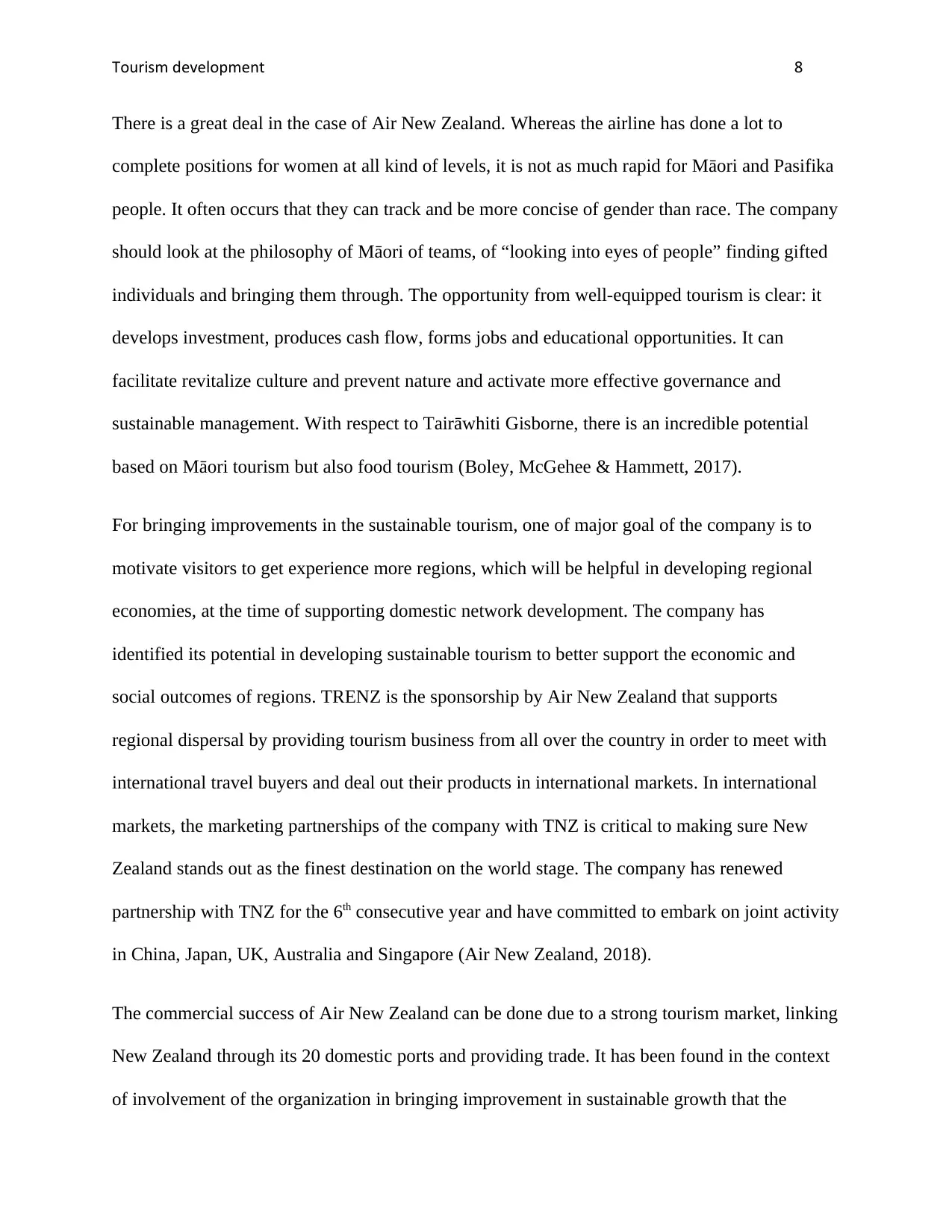
Tourism development 8
There is a great deal in the case of Air New Zealand. Whereas the airline has done a lot to
complete positions for women at all kind of levels, it is not as much rapid for Māori and Pasifika
people. It often occurs that they can track and be more concise of gender than race. The company
should look at the philosophy of Māori of teams, of “looking into eyes of people” finding gifted
individuals and bringing them through. The opportunity from well-equipped tourism is clear: it
develops investment, produces cash flow, forms jobs and educational opportunities. It can
facilitate revitalize culture and prevent nature and activate more effective governance and
sustainable management. With respect to Tairāwhiti Gisborne, there is an incredible potential
based on Māori tourism but also food tourism (Boley, McGehee & Hammett, 2017).
For bringing improvements in the sustainable tourism, one of major goal of the company is to
motivate visitors to get experience more regions, which will be helpful in developing regional
economies, at the time of supporting domestic network development. The company has
identified its potential in developing sustainable tourism to better support the economic and
social outcomes of regions. TRENZ is the sponsorship by Air New Zealand that supports
regional dispersal by providing tourism business from all over the country in order to meet with
international travel buyers and deal out their products in international markets. In international
markets, the marketing partnerships of the company with TNZ is critical to making sure New
Zealand stands out as the finest destination on the world stage. The company has renewed
partnership with TNZ for the 6th consecutive year and have committed to embark on joint activity
in China, Japan, UK, Australia and Singapore (Air New Zealand, 2018).
The commercial success of Air New Zealand can be done due to a strong tourism market, linking
New Zealand through its 20 domestic ports and providing trade. It has been found in the context
of involvement of the organization in bringing improvement in sustainable growth that the
There is a great deal in the case of Air New Zealand. Whereas the airline has done a lot to
complete positions for women at all kind of levels, it is not as much rapid for Māori and Pasifika
people. It often occurs that they can track and be more concise of gender than race. The company
should look at the philosophy of Māori of teams, of “looking into eyes of people” finding gifted
individuals and bringing them through. The opportunity from well-equipped tourism is clear: it
develops investment, produces cash flow, forms jobs and educational opportunities. It can
facilitate revitalize culture and prevent nature and activate more effective governance and
sustainable management. With respect to Tairāwhiti Gisborne, there is an incredible potential
based on Māori tourism but also food tourism (Boley, McGehee & Hammett, 2017).
For bringing improvements in the sustainable tourism, one of major goal of the company is to
motivate visitors to get experience more regions, which will be helpful in developing regional
economies, at the time of supporting domestic network development. The company has
identified its potential in developing sustainable tourism to better support the economic and
social outcomes of regions. TRENZ is the sponsorship by Air New Zealand that supports
regional dispersal by providing tourism business from all over the country in order to meet with
international travel buyers and deal out their products in international markets. In international
markets, the marketing partnerships of the company with TNZ is critical to making sure New
Zealand stands out as the finest destination on the world stage. The company has renewed
partnership with TNZ for the 6th consecutive year and have committed to embark on joint activity
in China, Japan, UK, Australia and Singapore (Air New Zealand, 2018).
The commercial success of Air New Zealand can be done due to a strong tourism market, linking
New Zealand through its 20 domestic ports and providing trade. It has been found in the context
of involvement of the organization in bringing improvement in sustainable growth that the
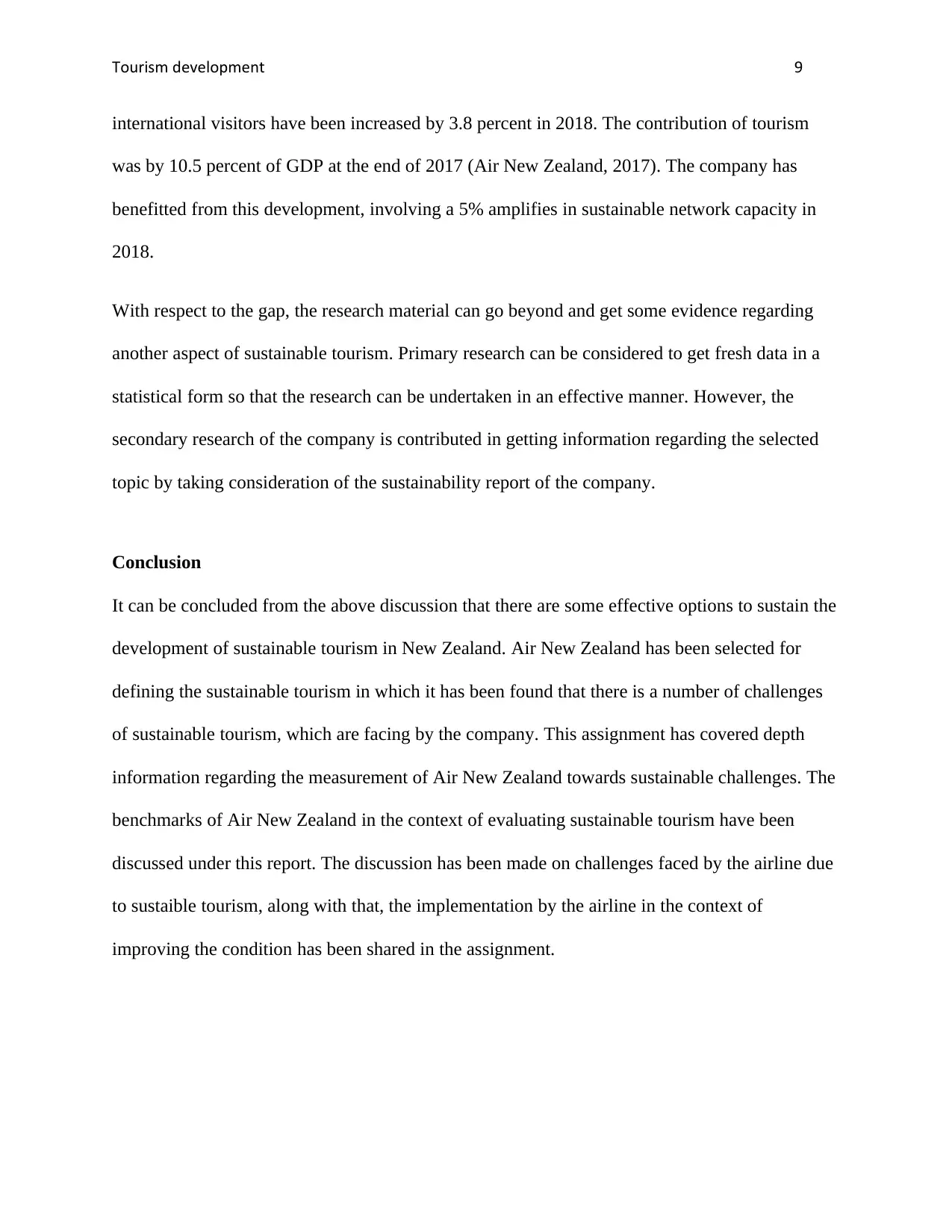
Tourism development 9
international visitors have been increased by 3.8 percent in 2018. The contribution of tourism
was by 10.5 percent of GDP at the end of 2017 (Air New Zealand, 2017). The company has
benefitted from this development, involving a 5% amplifies in sustainable network capacity in
2018.
With respect to the gap, the research material can go beyond and get some evidence regarding
another aspect of sustainable tourism. Primary research can be considered to get fresh data in a
statistical form so that the research can be undertaken in an effective manner. However, the
secondary research of the company is contributed in getting information regarding the selected
topic by taking consideration of the sustainability report of the company.
Conclusion
It can be concluded from the above discussion that there are some effective options to sustain the
development of sustainable tourism in New Zealand. Air New Zealand has been selected for
defining the sustainable tourism in which it has been found that there is a number of challenges
of sustainable tourism, which are facing by the company. This assignment has covered depth
information regarding the measurement of Air New Zealand towards sustainable challenges. The
benchmarks of Air New Zealand in the context of evaluating sustainable tourism have been
discussed under this report. The discussion has been made on challenges faced by the airline due
to sustaible tourism, along with that, the implementation by the airline in the context of
improving the condition has been shared in the assignment.
international visitors have been increased by 3.8 percent in 2018. The contribution of tourism
was by 10.5 percent of GDP at the end of 2017 (Air New Zealand, 2017). The company has
benefitted from this development, involving a 5% amplifies in sustainable network capacity in
2018.
With respect to the gap, the research material can go beyond and get some evidence regarding
another aspect of sustainable tourism. Primary research can be considered to get fresh data in a
statistical form so that the research can be undertaken in an effective manner. However, the
secondary research of the company is contributed in getting information regarding the selected
topic by taking consideration of the sustainability report of the company.
Conclusion
It can be concluded from the above discussion that there are some effective options to sustain the
development of sustainable tourism in New Zealand. Air New Zealand has been selected for
defining the sustainable tourism in which it has been found that there is a number of challenges
of sustainable tourism, which are facing by the company. This assignment has covered depth
information regarding the measurement of Air New Zealand towards sustainable challenges. The
benchmarks of Air New Zealand in the context of evaluating sustainable tourism have been
discussed under this report. The discussion has been made on challenges faced by the airline due
to sustaible tourism, along with that, the implementation by the airline in the context of
improving the condition has been shared in the assignment.
⊘ This is a preview!⊘
Do you want full access?
Subscribe today to unlock all pages.

Trusted by 1+ million students worldwide

Tourism development 10
References
References
Paraphrase This Document
Need a fresh take? Get an instant paraphrase of this document with our AI Paraphraser
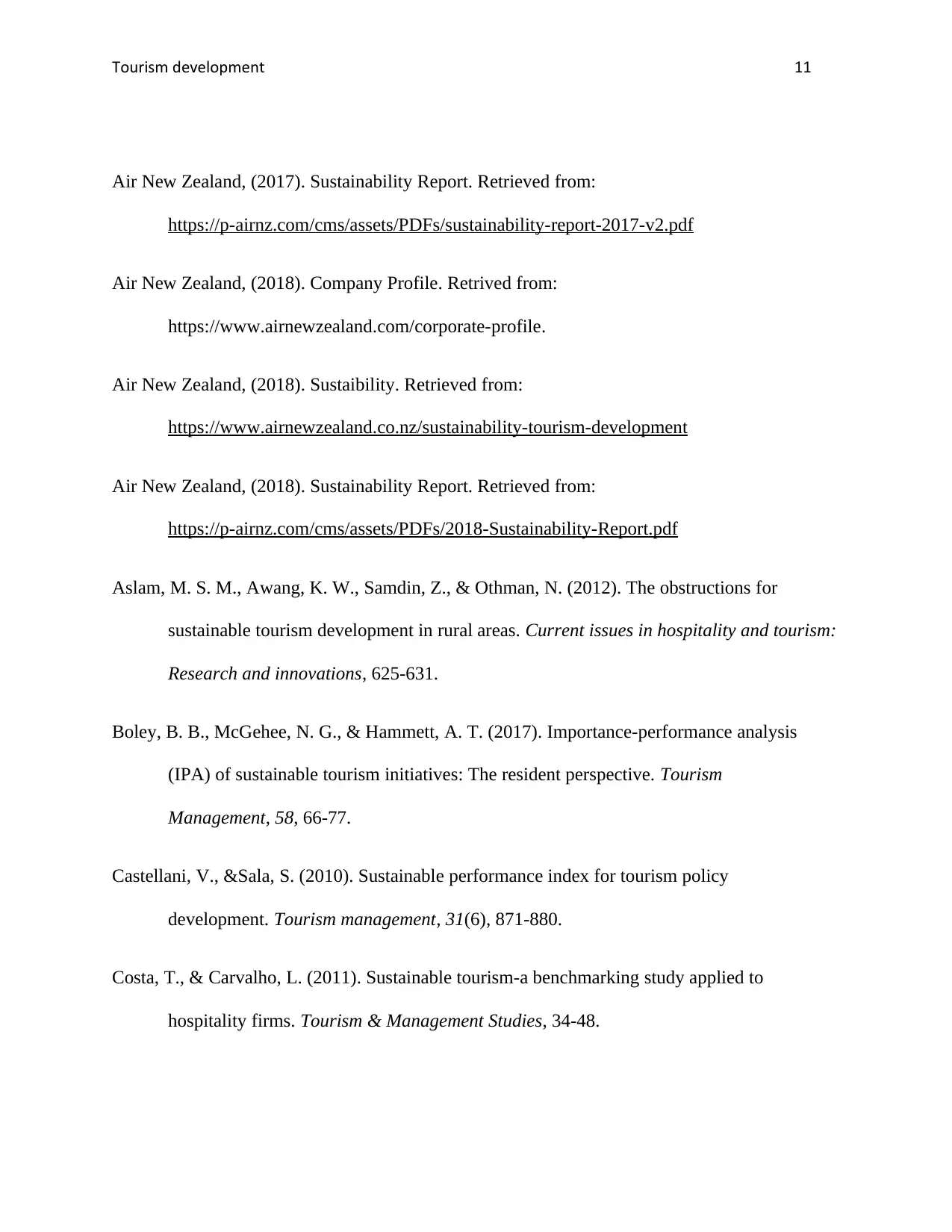
Tourism development 11
Air New Zealand, (2017). Sustainability Report. Retrieved from:
https://p-airnz.com/cms/assets/PDFs/sustainability-report-2017-v2.pdf
Air New Zealand, (2018). Company Profile. Retrived from:
https://www.airnewzealand.com/corporate-profile.
Air New Zealand, (2018). Sustaibility. Retrieved from:
https://www.airnewzealand.co.nz/sustainability-tourism-development
Air New Zealand, (2018). Sustainability Report. Retrieved from:
https://p-airnz.com/cms/assets/PDFs/2018-Sustainability-Report.pdf
Aslam, M. S. M., Awang, K. W., Samdin, Z., & Othman, N. (2012). The obstructions for
sustainable tourism development in rural areas. Current issues in hospitality and tourism:
Research and innovations, 625-631.
Boley, B. B., McGehee, N. G., & Hammett, A. T. (2017). Importance-performance analysis
(IPA) of sustainable tourism initiatives: The resident perspective. Tourism
Management, 58, 66-77.
Castellani, V., &Sala, S. (2010). Sustainable performance index for tourism policy
development. Tourism management, 31(6), 871-880.
Costa, T., & Carvalho, L. (2011). Sustainable tourism-a benchmarking study applied to
hospitality firms. Tourism & Management Studies, 34-48.
Air New Zealand, (2017). Sustainability Report. Retrieved from:
https://p-airnz.com/cms/assets/PDFs/sustainability-report-2017-v2.pdf
Air New Zealand, (2018). Company Profile. Retrived from:
https://www.airnewzealand.com/corporate-profile.
Air New Zealand, (2018). Sustaibility. Retrieved from:
https://www.airnewzealand.co.nz/sustainability-tourism-development
Air New Zealand, (2018). Sustainability Report. Retrieved from:
https://p-airnz.com/cms/assets/PDFs/2018-Sustainability-Report.pdf
Aslam, M. S. M., Awang, K. W., Samdin, Z., & Othman, N. (2012). The obstructions for
sustainable tourism development in rural areas. Current issues in hospitality and tourism:
Research and innovations, 625-631.
Boley, B. B., McGehee, N. G., & Hammett, A. T. (2017). Importance-performance analysis
(IPA) of sustainable tourism initiatives: The resident perspective. Tourism
Management, 58, 66-77.
Castellani, V., &Sala, S. (2010). Sustainable performance index for tourism policy
development. Tourism management, 31(6), 871-880.
Costa, T., & Carvalho, L. (2011). Sustainable tourism-a benchmarking study applied to
hospitality firms. Tourism & Management Studies, 34-48.
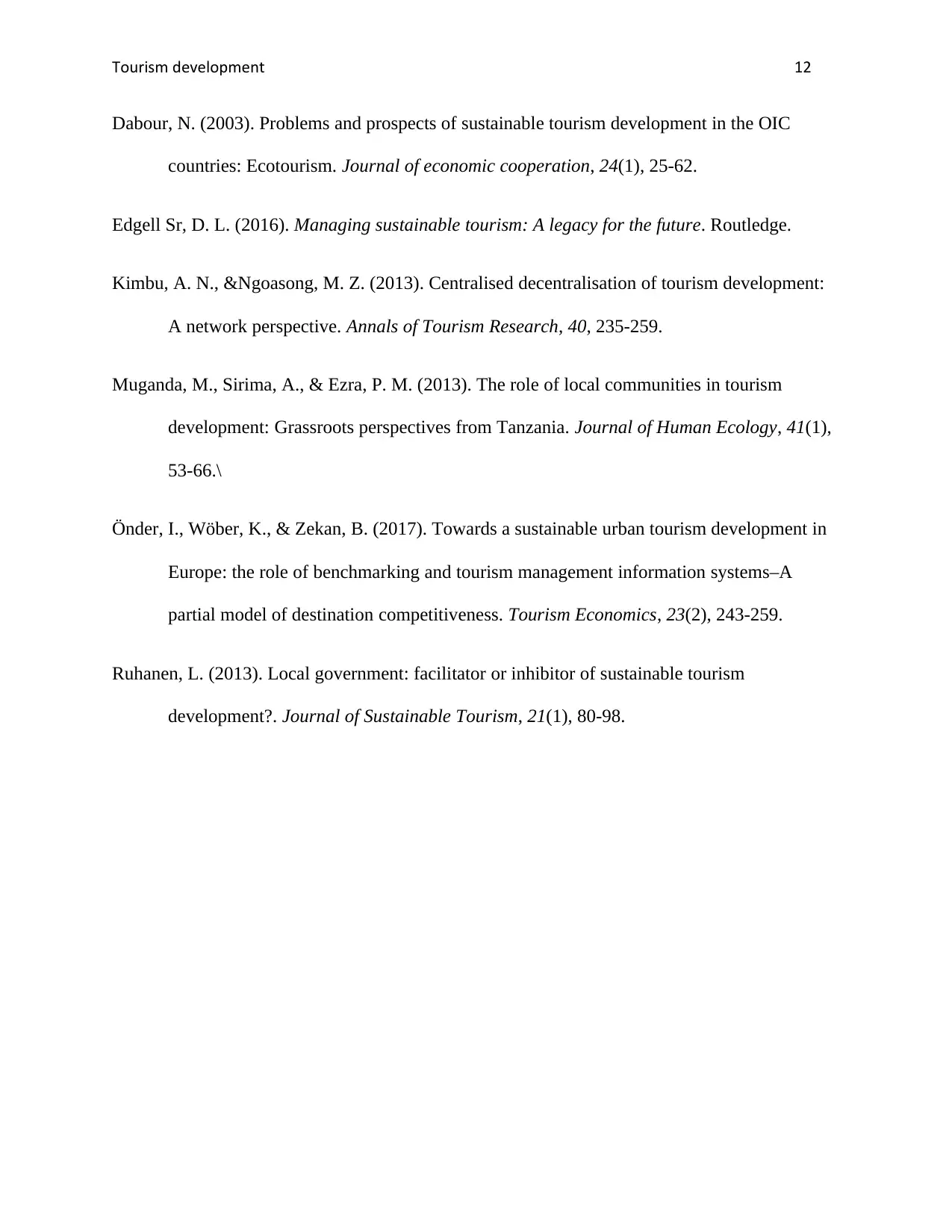
Tourism development 12
Dabour, N. (2003). Problems and prospects of sustainable tourism development in the OIC
countries: Ecotourism. Journal of economic cooperation, 24(1), 25-62.
Edgell Sr, D. L. (2016). Managing sustainable tourism: A legacy for the future. Routledge.
Kimbu, A. N., &Ngoasong, M. Z. (2013). Centralised decentralisation of tourism development:
A network perspective. Annals of Tourism Research, 40, 235-259.
Muganda, M., Sirima, A., & Ezra, P. M. (2013). The role of local communities in tourism
development: Grassroots perspectives from Tanzania. Journal of Human Ecology, 41(1),
53-66.\
Önder, I., Wöber, K., & Zekan, B. (2017). Towards a sustainable urban tourism development in
Europe: the role of benchmarking and tourism management information systems–A
partial model of destination competitiveness. Tourism Economics, 23(2), 243-259.
Ruhanen, L. (2013). Local government: facilitator or inhibitor of sustainable tourism
development?. Journal of Sustainable Tourism, 21(1), 80-98.
Dabour, N. (2003). Problems and prospects of sustainable tourism development in the OIC
countries: Ecotourism. Journal of economic cooperation, 24(1), 25-62.
Edgell Sr, D. L. (2016). Managing sustainable tourism: A legacy for the future. Routledge.
Kimbu, A. N., &Ngoasong, M. Z. (2013). Centralised decentralisation of tourism development:
A network perspective. Annals of Tourism Research, 40, 235-259.
Muganda, M., Sirima, A., & Ezra, P. M. (2013). The role of local communities in tourism
development: Grassroots perspectives from Tanzania. Journal of Human Ecology, 41(1),
53-66.\
Önder, I., Wöber, K., & Zekan, B. (2017). Towards a sustainable urban tourism development in
Europe: the role of benchmarking and tourism management information systems–A
partial model of destination competitiveness. Tourism Economics, 23(2), 243-259.
Ruhanen, L. (2013). Local government: facilitator or inhibitor of sustainable tourism
development?. Journal of Sustainable Tourism, 21(1), 80-98.
⊘ This is a preview!⊘
Do you want full access?
Subscribe today to unlock all pages.

Trusted by 1+ million students worldwide
1 out of 12
Related Documents
Your All-in-One AI-Powered Toolkit for Academic Success.
+13062052269
info@desklib.com
Available 24*7 on WhatsApp / Email
![[object Object]](/_next/static/media/star-bottom.7253800d.svg)
Unlock your academic potential
Copyright © 2020–2025 A2Z Services. All Rights Reserved. Developed and managed by ZUCOL.





